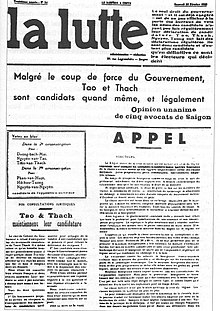La Lutte (newspaper)
La Lutte ('The Struggle') was a left-wing paper published (in French to get around print restrictions on Vietnamese) in Saigon, French-colonial Cochinchina (southern Vietnam), in the 1930s.
[3] Edgar Ganofsky, a Frenchman from the island of Réunion who identified with the coolies among whom he lodged, lent his French citizenship and experience in publishing his own paper La Voix Libre [The Free Voice], in assuming official managerial responsibility for the newspaper.
[3] Moreover, the election was preceded by a controversy within the La Lutte alliance regarding the candidature of Duong Bach Mai, a Communist Party leader.
[12] Unwilling to further muzzle criticism of the "Stalinists" and the Communist Party, early in 1936 Ho Huu Tuong and Ngo Van withdrew from La Lutte.
With the League of Internationalist Communists for the Construction of the Fourth International they began publication of their own weekly "organ of proletarian defence and Marxist combat," Le Militant.
The split in La Lutte was finalized on June 14, 1937, when the Communist Party refused to support Thau's motion against the Popular Front government.
[18] With La Lutte now an openly Trotskyist paper, and with a Vietnamese-language edition (Tranh Dau),[19] Tạ Thu Thâu led a "Workers' and Peasants' Slate" into victory over both the Constitutionalists and the PCI's Democratic Front in the April 1939 Cochinchina Council elections.
In spite of their radical programme, the election could be understood, at least in part, as a tax payers' protest against the new national defence levy that the Communist Party, in the spirit of Franco-Soviet accord, had felt obliged to support.
[22] Dương Bạch Mai, who had been among the Stalinists on the original editorial board of La Lutte,[23] led Vietminh security in hunting down his former colleagues on the paper.
